Occupational Outlook Handbook Free Download Pdf
From its start in 1949 as a gathering of reports mainly intended to assist veterans to today's popular online guide, the Occupational Outlook Handbook has been updated and improved to benefit students, career seekers, and others looking for career guidance.
The Bureau of Labor Statistics (BLS) Occupational Outlook Handbook turned 70 years old in 2019.1 Also known as the "OOH" or just the "Handbook," this mainstay of career guidance has been an important source for people seeking information about careers since its inception.
The OOH has had several changes over its 70-year history, from its beginning as a book sold by the U.S. Government Printing Office (GPO), now known as U.S. Government Publishing Office, to its current incarnation as a web-only publication. It was updated irregularly in the beginning but settled into a 2-year cycle in 1966. When BLS launched its website in January 1995, the OOH was posted online shortly thereafter. However, the content was a replica of the printed Handbook. By 2008, the idea of a redesigned Occupational Outlook Handbook took root—an OOH that would be more in tune with the way that people search for, read, and use information in the digital age. The redesigned, online-only OOH was published in 2012 on the BLS website. The OOH remains the most popular product on the BLS website in terms of page views. From June to August 2019, OOH pages had 6.5 million page views, or about one-quarter of all page views of the BLS website.2
This article describes how and why the OOH has changed since its first publication in 1949. It details how BLS went about redesigning the Handbook, considering user needs and preferences while still maintaining the important information on which its users depend.
The Occupational Outlook Handbook in print
The first OOH took more than 10 years to develop. The impetus was a 1938 report from the Advisory Committee on Education, a committee established by President Franklin D. Roosevelt. The report recommended that an occupational outlook service be created to provide employment outlooks by occupation and that BLS carry out that service.3 Acting BLS Commissioner A. Ford Hinrichs requested funding from Congress to start the program, and it was provided in 1940. The Veterans Administration (VA), renamed the Department of Veterans Affairs in 1989, also provided funding in the early 1940s to supplement BLS resources. The early research from BLS consisted of short occupational reports, which the VA used to create a manual by punching holes in the reports and binding them together with shoelaces.
BLS began publishing employment outlook bulletins on specific occupations in 1945. In the late 1940s, BLS continued to research occupations and also worked to understand user needs by attending vocational guidance conventions and visiting school counselors.
In 1949, BLS published the first edition of the OOH, under BLS Commissioner Ewan Clague.4 This first OOH covered 288 occupations, which were chosen mainly because the VA thought they would be of interest to veterans.5 The GPO sold 40,000 copies of this 1949 Handbook, which former BLS Associate Commissioner Harold Goldstein wrote was "astonishing."6
BLS continued to produce periodic versions of the Handbook, typically at 2-year intervals, and created the last print edition (sold by the GPO) in January 2010. (See figure 1 for images of the BLS commissioners and the first OOH cover.)
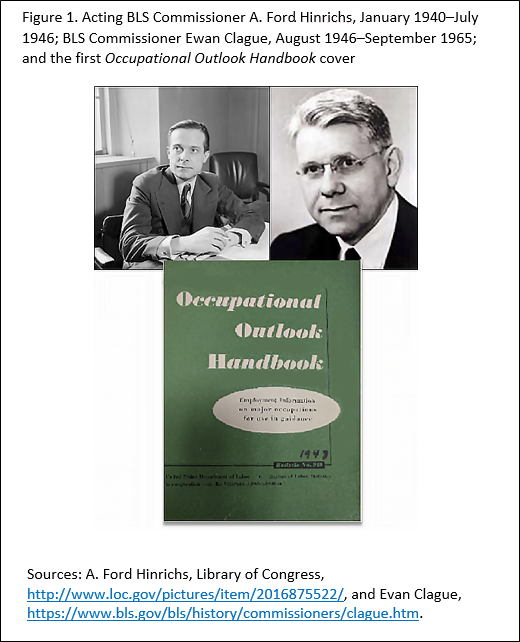

Notable changes over the print edition years
From its first publication in 1949 through the last print edition BLS published in January 2010, OOH occupations changed, as did the sources of the data used for employment and wages. The OOH added several new occupations over the years, while others were eliminated.
Occupational coverage
Until the early 1980s, the occupations covered in the Handbook were chosen regardless of whether reliable statistical data existed on them. Criteria for occupational coverage included whether the occupations were large in terms of employment, required a lot of training, or were simply thought to be of interest. Budget availability and staff resources also affected the number of occupations covered in the OOH.7
Some occupations dwindled in importance over time (or disappeared from the economy), and new occupations emerged.8 Occupations covered in the 1949 edition included many that do not exist today, such as fur blenders, blacksmiths, typewriter servicemen, and hostlers. Occupations such as these were removed from the Handbook as demand for their services in the economy lessened and employment declined. The OOH gained new occupations as the use of technology grew and computer-related occupations emerged. Computer programmers, for example, first appeared in the OOH in 1959 and systems analysts about a decade later.9
Gender stereotyping
The first OOH included occupations with gender-specific titles, such as lay-out men and the above-mentioned typewriter servicemen; airplane hostesses and flight stewards; and chainmen, rodmen, and axmen. The occupational reports also included the pronouns "he" or "she" for occupations dominated by men or women and had statements such as "Men serving as ship operators must hold first- or second-class radio telegraph licenses issued by the Federal Communications Commission." Many reports even discussed work opportunities by gender. For example, the outlook section for chiropractors said, "Opportunities for women appear to be good, as many women prefer to go to members of their own sex for treatment."10
Beginning with the 1957 OOH, BLS set a goal to have more information about women's employment in the Handbook. However, BLS stopped mentioning women's employment in the OOH by the mid-1970s to avoid a perception of stereotyping by gender, since several occupations were dominated by women or else had very few women employed.11 BLS mostly adopted non-gender-specific titles with the release of the 1976–77 OOH. Any remaining gender-specific titles in the OOH were eliminated when BLS moved to the Standard Occupational Classification system, which is used by federal agencies to collect and analyze data by occupation.
Data sources
Beginning with the release of the 1984–85 OOH, occupations covered were required to have employment data from the Occupational Employment Statistics (OES) survey.12 Prior to this time, if no employment data were available, BLS relied on estimates from various associations or organizations that represented occupations. Other government agencies or bureaus produced some material.
The OOH used various data on wages over the years, including data from the Current Population Survey, the Current Employment Statistics survey, and other sources. The sources were not consistent because the data were not available for all occupations. With the 2000–01 edition, the OOH began using median wage data from the OES survey. The OES data are still used today.
The first web presence
BLS launched its first website in January 1995 at www.bls.gov. The 1996–97 edition of the OOH was added to the BLS website about 6 months later. Although the layout of the OOH pages on the website changed a few times, what BLS posted on its website prior to the 2012 redesign was a replica of printed pages in the book, and the book was still being sold by the GPO and other vendors. (See figure 2 for images of OOH looks for financial managers.)
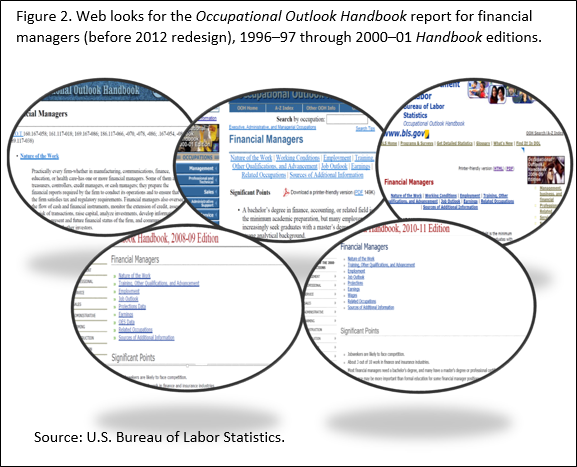
Redesigning the OOH for the web
Modernizing the OOH was an important part of the 2008 strategic plan for the BLS Employment Projections (EP) program. Identifying and meeting customer needs was a goal of the strategic plan, and the EP program knew that the OOH needed to be revamped to better meet those needs. Since the online version at the time was simply a replica of text from the book, BLS was not taking advantage of ways to present the information on the web. Reinventing the OOH was therefore a high priority of the BLS, and the redesign was a goal of the overall BLS strategic plan released in November 2010.13
Evaluating stakeholder needs and preferences
BLS collected extensive feedback from external stakeholders to create a plan for the redesign. BLS collected this information via several methods, including through focus groups with counselors; usability tests with students, adult workers, and job seekers; and interviews with technical users. Some of the feedback was collected during sessions at the BLS cognitive laboratory at its headquarters in Washington, DC. Usability tests included observing participants completing various tasks, recording the time participants needed to complete the tasks, and having the participants rate the difficulty of the tasks.
In addition, BLS reviewed the results of the American Customer Satisfaction Index (ACSI), which was based on a survey conducted by ForeSee. The survey included questions about content, functionality, look and feel, navigation, search, and site performance.
BLS also reviewed OOH product use to evaluate demand for OOH information and how users were getting that information. BLS analyzed (1) traffic to the OOH website, (2) trends in print sales of the Handbook, and (3) requests for information received by telephone, regular mail, and email.
Redesign focus
The information gathered from stakeholders provided many goals for the redesign, including the following:
· An updated and more modern look
· Improved search functions, navigation, and organization
· Easily scanned information that uses bullets and summaries
· Plain language text that is written for the web
· Understandable headings and terminology
· Data for states and local areas
· Web-specific design, such as graphics, photographs, and charts
· Continuously updated information
A team of BLS staff members, consisting of economists, a survey methodologist, a research psychologist, and information technology experts, redesigned the Handbook.14 The team prepared prototypes of OOH pages, including the "landing pages" (pages that serve as gateways to other pages), the home page, and the occupational profile pages themselves. Usability tests of the prototypes were conducted with students, working adults, and counselors, including attendees at national conferences for counselors. In addition, BLS continued to collect feedback on the various prototypes through focus groups and card-sorting exercises.
BLS decided to devote resources to developing the redesigned OOH as a web-only publication and to no longer produce pages for a print version to be sold by the GPO. Sales of the GPO-printed Handbook had been declining dramatically since about the mid-1980s, which was when the OOH was first published by a private publisher. Sales continued to decline as the OOH was published on the web about 10 years later. (See figure 3.) BLS surveyed a number of users, including individuals and organizations who had purchased a copy from the GPO, attendees at professional counselor conferences, and other audiences. Analyses indicated that students preferred an online version and that counselors also preferred it. BLS determined that private publishers could continue to meet the demand for a printed book.
BLS decided to have the redesigned OOH produced via a content management system (CMS), and it was the first BLS product to be published with this system. A CMS allows staff to review and edit content through a flow process and produces HTML for web pages. It allows the authors and reviewers to immediately preview the webpages before approving them for publication. BLS also produced a mobile version of the OOH using the CMS, which was important in modernizing the guide. The mobile version optimized the appearance and usage of the OOH on mobile phones and tablets.
Design principles for a web OOH
BLS incorporated most of what users wanted and preferred in the redesigned Handbook (some enhancements came later; see the section later in this article on improvements since the redesign). The design provides numerous navigation and search options, with better organization of the content. Navigation and search options include occupational groups landing pages and an occupation finder. The occupational groups landing pages display summary information about related occupations, such as entertainment and sports. With the occupation finder, a user can search occupations by combinations of various characteristics: entry-level education, on-the-job training, projections of new jobs and the growth rate, and pay. (See figure 4 for an example of an occupation finder result for occupations that typically need a bachelor's degree for entry.)
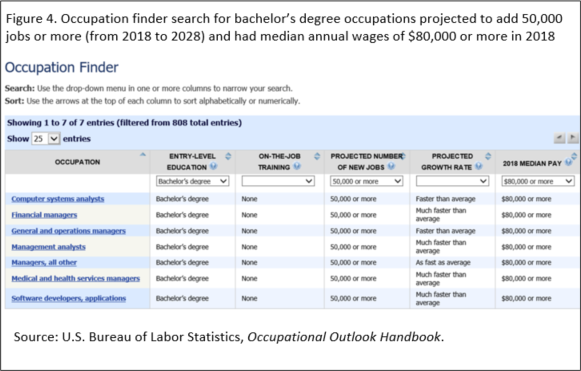
Additional navigation capabilities include an A–Z index and a content search. The OOH home page has links to charts by which users can view the highest paid occupations, fastest growing occupations, and occupations with the most new jobs. The charts provide links to further information (including occupational profiles) for each occupation shown.
The occupational profiles have information displayed in a "tab" format across the page by topic, along with information in bulleted lists, tables, and charts. User testing showed that users preferred a tab format over a long page that required scrolling and also showed that they completed tasks more quickly. Users can easily navigate through a profile by selecting the appropriate tab or by clicking on arrows at the bottom of each page. The occupational profile tabs have understandable headings and are search-engine optimized, which means that they are more likely to appear high on a list of results returned by a search engine. The first tab is a summary page that allows users to quickly scan the occupation. It includes a "Quick Facts" table with key information. Other tabs describe duties, work environment, education and training requirements, pay, and the job outlook for the occupation. The pay and job outlook tabs contain charts that allow users to compare the pay and outlook for an occupation to the total for all occupations and to the major occupation group to which the occupation belongs. The tab for state and area data provides sources of information on state and area employment, projections, and wages (this tab was not part of the initial release of the redesigned OOH and was added in 2015). (See figure 5 for an image of the occupational profile for financial managers.)
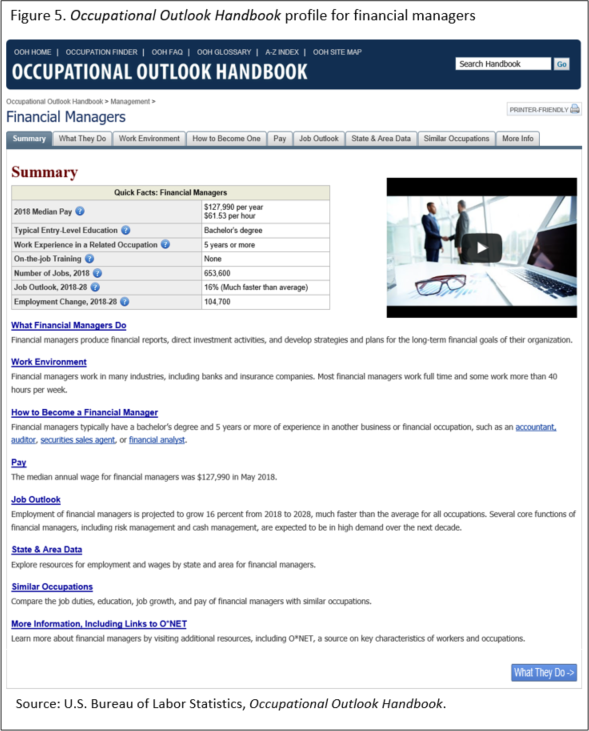
Text rewritten for the web
The somewhat dense and lengthy text in the print OOH was not suitable for today's readers for a website. Web content needs to be high quality and to retain the important information that users want. To ensure this level of quality, BLS contracted an outside expert to train and guide staff on writing for the web.15 Staff learned a number of key points for successful web writing, including the following:
· Ensure the key message or main point comes first.
· Use as few words as possible to get the point across.
· Use the simplest words to express the correct meaning so that all web readers easily understand the text.
· Write short paragraphs and sentences using active voice, if possible.
· Use bullets, which web readers can more easily scan, rather than dense text.
BLS economists prepared 341 occupational profiles (covering 536 occupations), keeping in mind the principles of writing for the web. This effort resulted in more content in the web redesign OOH than had been in the print OOH. Individual profiles were added for all the science and engineering occupations, which had been covered in groups in the print OOH. In addition, new occupational profiles covering various computer and business occupations were added, among others.
The redesigned OOH and further improvements
The redesigned OOH was released on March 29, 2012, and was based on employment projections for the 2010–20 decade. It included about 50 more occupational profiles than the print version. BLS has subsequently updated the OOH with the most recent projections data as they have become available, along with incorporating new research regarding the occupations and updated wage data.
The number of OOH page views increased substantially after the redesigned version was released in March 2012. In the 12 months following the release, the number of page views totaled more than 117 million, an increase of about 42 percent over the 12 months after the prior (before the redesign) OOH was released. (See figure 6.) Among the reasons for the increased views were the additional occupational profiles and the new mobile site, which itself received 8.9 million views. To help gauge the extent that the redesign had on usage, BLS compared, between the print version and the redesigned version, page views of profiles that had identical occupational coverage. Views of these profiles grew by 10.8 percent.16
BLS also used a survey to evaluate the success of the redesigned OOH in meeting customer needs and to determine if anything could be done better. The survey was posted on the BLS website in 2013 and received 2,250 responses. BLS also sought feedback directly from the counselor community. The National Association of College and Employers (NACE) posted a link to the survey on its website, which generated 357 responses.17 The NACE member population is different from the general population that completed the survey on the BLS website, since nearly all respondents from NACE indicated they were familiar with the OOH, whereas the general population indicated less familiarity.
Respondents to both surveys rated the redesign of the OOH highly successful. The response rates from NACE were somewhat higher than those from the general population, which may again reflect the greater familiarity of the NACE members with the OOH. The survey asked if the redesigned OOH was an improvement over the prior version. Of those users familiar with the OOH, 84 percent of the general population felt the redesigned Handbook was improved over the previous version (either much improved, somewhat improved, or a little improved), and 91 percent of NACE respondents felt the same. Questions were asked about satisfaction with (1) retaining important information, (2) navigation, (3) attractiveness, and (4) readability. Most of the general population respondents felt the efforts in each area were successful (either very successful or successful), ranging from 68 percent for retaining important information to 75 percent for readability. For the NACE respondents, satisfaction ratings ranged from 80 percent for readability to 87 percent believing the redesign was successful in retaining important information. Of the general population and the NACE respondents, 87 percent and 93 percent, respectively, rated the redesigned OOH as an excellent or good source of career information. Through several open-ended questions, both sources suggested improvements.
BLS again analyzed results from the ACSI after the redesigned version was posted. BLS compared results for April to August 2012 with results just prior to the redesign (January to March 2012). During this period, about 4,000 visitors to the OOH website completed surveys. Overall satisfaction increased after the redesigned version was posted. The ratings for the drivers of satisfaction—search, functionality, look and feel, and navigation—all grew.18 (See figure 7.)
Since redesigning the OOH, BLS has improved the website further on the basis of user feedback. As noted earlier, a "State & Area Data" tab was added to all occupational profiles in December 2015 to assist customers find information specific to states and local areas. The OOH was updated with the most current OES wage data in spring 2016. Updating the OOH with current data as soon as the data were released is a change from the previous practice of making the wage update at the same time as the projections release, which was a legacy from producing the print version. BLS will continue to update the wages in the Handbook as soon as the data are released. In addition, BLS added career videos to occupational profiles beginning in 2017.19 Video content was produced by the U.S. Department of Labor's CareerOneStop in consultation with BLS subject matter experts. Nearly all profiles in the OOH currently have a career video embedded on their summary pages.
Recent and upcoming enhancements
BLS continues to strive to improve its products, including the projections data that form the basis of the Handbook. BLS will begin releasing projections data annually to provide more timely information. The last set of biennial employment projections (for the 2018–28 decade) was released in September 2019. BLS plans to release its first set of annual projections, for the 2019–29 period, in 2020. The OOH will continue to incorporate the latest projections as they are released.
In addition, BLS continues to strive to provide timely information by keeping all occupational profiles up to date. Not only are the projections and wage data incorporated as soon as possible but also other updates are being published when ready. For example, when licensure requirements change for an occupation, BLS does not have to wait for a specific publication date to update information, as was the case when the OOH was a printed volume. BLS now revises the OOH as soon as the research is complete.
BLS released an OOH app (application) in fall 2019.20 Many people access the internet using a smartphone, which is the main source of internet access for some. According to a Pew Research Center study, 81 percent of Americans have a smartphone, with 96 percent of people ages 18 to 29 owning one.21 This age group is a key demographic for the OOH. Pew also notes that the percentage of people who use smartphones to access the internet has been growing for all age groups.22 The OOH app will provide an additional avenue for all users to access career information and will let users personalize the app by filtering searches and by "liking," saving, viewing, and comparing favorites. (See figure 8 for an image of the app.)
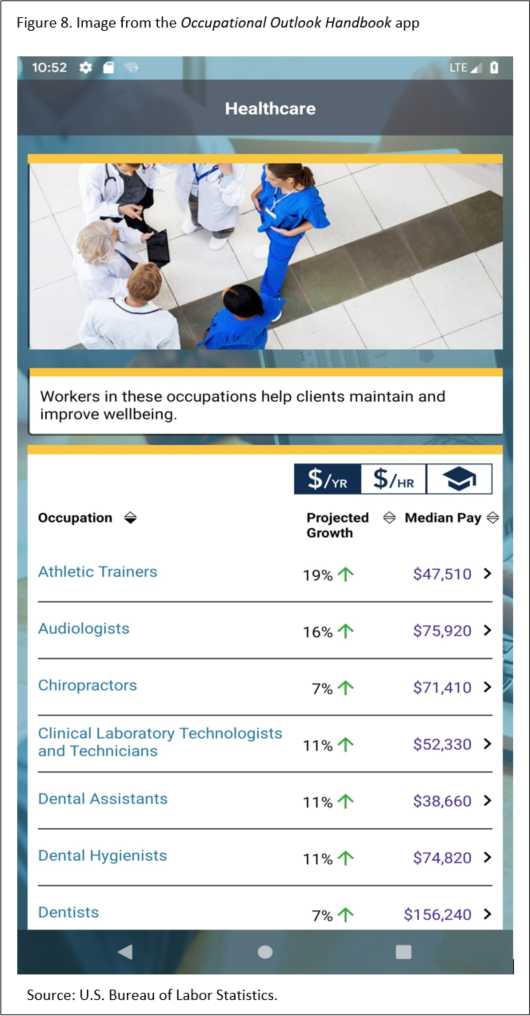

BLS is planning an upcoming enhancement to the Handbook using field of degree data from the American Community Survey, administered by the U.S. Census Bureau. The new pages for fields of degree will include information about which occupations are most popular for those with a bachelor's degree in various fields and a link to the relevant occupational profiles, along with data on the employment outlook, median wage, and more. These pages will provide statistics for graduates with specific degree types within a field compared with all graduates in that field. For example, the page for the biology field will have information about specific types of biology degrees, such as general, zoology, and microbiology. The field of degree pages will provide more ways for users to search for occupations of interest to them and navigate between them.
Conclusion
The first semblance of career guidance from BLS was an assortment of pamphlets tied together and distributed by the Veterans Administration in 1946. In 1949, BLS published the first Occupational Outlook Handbook, and in 2012, redesigned the Handbook as a web publication. BLS continues to serve the customer by regularly improving the OOH, keeping it useful and current.23 The OOH remains a popular and trusted source for career guidance 70 years after its inception.
Posted by: addieaddiepeveze0267603.blogspot.com
Source: https://www.bls.gov/opub/mlr/2019/article/70-years-of-the-occupational-outlook-handbook.htm
Post a Comment for "Occupational Outlook Handbook Free Download Pdf"